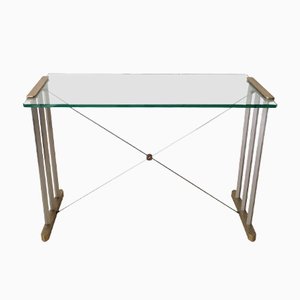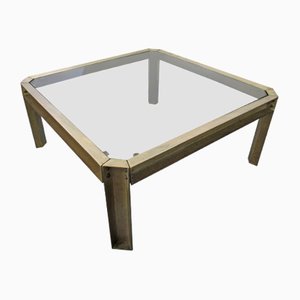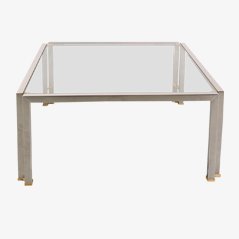German designer Peter Ghyczy reminisces about his pioneering career
50 Years of Functionalism
With a career that spans five decades, German designer Peter Ghyczy (b. 1940 in Budapest) is recognized as one of the great material innovators in design. His polyurethane Garden Egg Chair—the 1968 Space Age classic for which he is most widely known—epitomizes his persistent drive to harness technology in the creation of more functional and stylish living environments. To honor this design pioneer and his iconic design’s 50th anniversary, ADAM-Brussels Design Museum is now exhibiting Peter Ghyczy: 50 Years of Functionalism. Curated by Kunty Moureau, the show represents Ghyczy’s first solo exhibition and offers new insights into Ghyczy’s life and work.
An unswerving advocate for functionalist and sustainable design, Ghyczy founded his eponymous design company in Swalmen, the Netherlands in 1971. Early on, he invented a special clamping technique using a metal spanner that holds the glass in place, resulting in the illusion that the glass is floating on a frameless table. This technique, which was soon hailed as an elegant yet minimalist solution to avoid screws and glue, encouraged Ghyczy to continue down a path driven by technology. Over the decades that followed, he built of a body of design work that he has described as “eclectic Bauhaus minimalism.” Some of his notable, practical and yet sumptuous designs include the GN2 Easy Chair (1969), molded from a single piece of plastic, and the glass and brass T09 (1972) and T14 (1973) tables.
We had the opportunity to talk with Peter Ghyczy about his retrospective, the longevity of his career, and his dedication to design research. Read on for highlights from our conversation.
Rachel Miller: This is the world-first solo exhibition for your work. How exciting! Tell us a bit about the importance of this moment for you as a designer?
Peter Ghyczy: I am, of course, immensely proud to have my work exhibited at the ADAM-Brussels Design Museum, and I am excited to see how my designs will be presented through the eyes of someone else, namely the curator Kunty Moreau. In some ways, it feels like yesterday that I designed the Garden Egg Chair, but of course, this exhibition reminds me of the entire journey that has led to this wonderful moment in time.
RM: What are you hoping people will take away from this exhibition? What can people expect and what will they be surprised by?
PG: Most people will probably be familiar with my Garden Egg Chair—which they, of course, can expect to see—but this exhibition is really meant to show visitors the breadth and scope of my design capabilities; how my designs and use of material have evolved over the years. Although I always return to functionalism as my main guiding principle, the forms and tactility of my designs have certainly changed with an increasing focus on upholstery and patterns to suit the next generation of design enthusiasts. I hope this will be a key take-away from the exhibition.
I also hope that this exhibition will encourage visitors, whether young or old, to draw and sketch. Pen and paper have been my primary tools throughout my entire life, with countless hours spent in my little atelier. If others can become inspired to draw from this exhibition, I would be so pleased.
RM: During the 1960s, you began working with plastics producer Reuter. What was it like working with a now ubiquitous material that was so novel at the time?
PG: Working with Dr. Reuter, the inventor of polyurethane plastics, and his team in the Reuter Design Center was a fantastic opportunity; I look back on that experience with a great sense of joy. At the time, plastic was a new material that presented new manufacturing possibilities—the dream of every designer!
RM: How do you feel about plastic, or other synthetic materials, in a contemporary context?
PG: Today, hard plastic furniture has pretty much disappeared, although the material is still used in various ways from soft foam and textile coating to insulating material and high-quality rubber. After founding GHYCZY, I never returned to plastics as a material. Instead, environmental sustainability has remained a key motivation in my designs, which has led to a varied collection of high-quality products made with minimum waste.
RM: How would you characterize the overall aesthetic of your designs and the GHYCZY brand?
PG: The overarching principle of all of my designs have been functionalism and a love for materials. I believe the form of a design object should follow its inherent function or purpose, and it is the capabilities of the materials in making that object that set the limits. In turn, I would characterize the GHYCZY aesthetic as Bauhaus minimalism but with a twist of eclecticism, adding exotic Art Deco patterns and intricate details from Egyptian antiquity.
RM: How does the use of technology inform your designs? How do you marry technology with luxury?
PG: To me, technology is the process of manipulating materials in a certain way, through shape or by connecting two or more materials. Throughout my career, I have experimented with new technologies and pioneered new techniques to form my designs, such as the clamping technique. The luxury element comes from the use of high quality and expensive raw materials such as metal, glass, and wood. Using these high-quality materials to produce timeless design objects—that require minimal material and use minimal waste—results in a beautiful, yet sustainable product. And that is true luxury!
'Peter Ghyczy: 50 Years of Functionalism' runs February 7th to March 11th, 2018, at ADAM-Brussels Design Museum. The exhibition will also feature a design talk moderated by Alok Nandi on February 22nd, titled ‘In Conversation with Peter Ghyczy’. Open to the public, this design talk aims to give a personal insight into Peter Ghyczy’s reflections of his work and reactions to the exhibition on show.
In further celebration of Peter Ghyczy, the Kunstmuseen Krefeld will dedicate a room to the iconic designer within their exhibition ‘Idea to Form / Domeau & Pérès: Design and Craftsmanship’ in their Kaiser Wilhelm Museum space from 18 May –14 October 2018.
-
Text by
-
Rachel Miller
Rachel is a California native whose passion for travel has led her on some pretty crazy adventures around the world. After living in Korea for three years, she decided on a whim to move to Germany. While she still has a wandering soul, Berlin has captured her heart, and she's decided to make this multicultural hub her permanent home. Most of her free time is spent playing beach volleyball, exploring the city's many arty scenes, and hunting down Berlin's best craft beer.
-
Descubre otros productos
Consola de latón y acero de Peter Ghyczy, años 80

Large Vintage Brass and Glass Coffee Table by Peter Ghyczy

Mesa de centro vintage de vidrio y latón de Peter Ghyczy

Brass Side Table by Peter Ghyczy, 1970s

Mesa de centro Embassy de latón fundido de Peter Ghyczy, años 70

Lámpara de mesa de latón de Peter Ghyczy, años 80

Mesa de centro de vidrio de Peter Ghyczy, años 70

Brass & Glass Coffee Table by Peter Ghyczy, 1980s

Dutch Brass and Glass Coffee Table by Peter Ghyczy, 1970s


